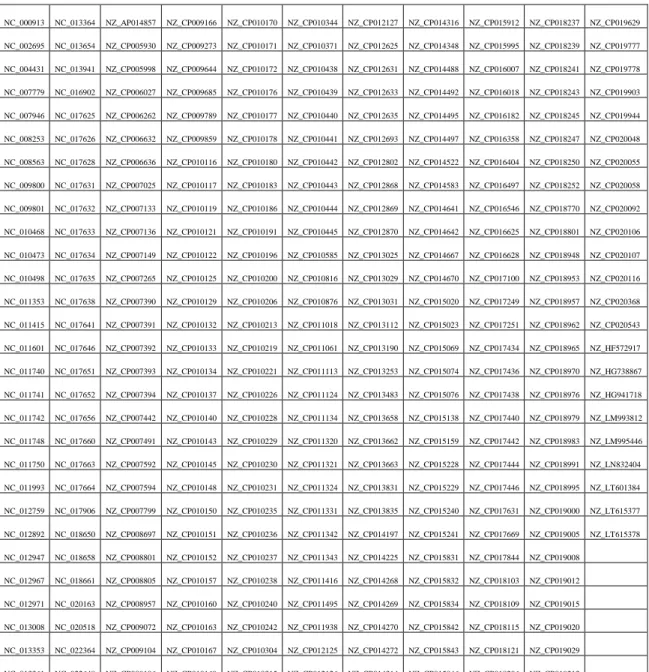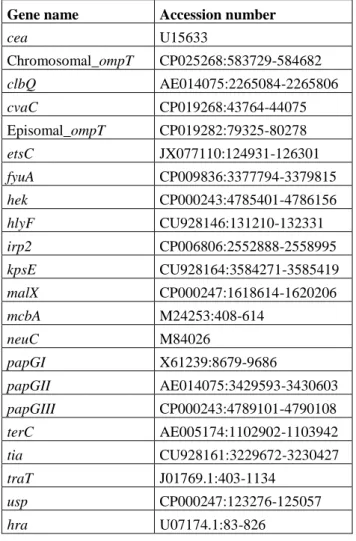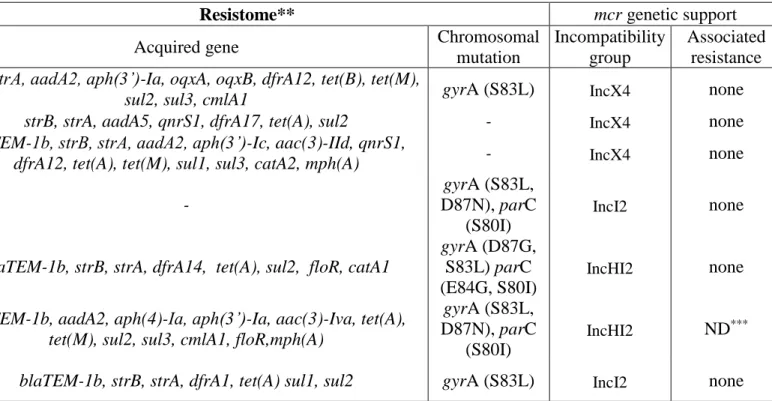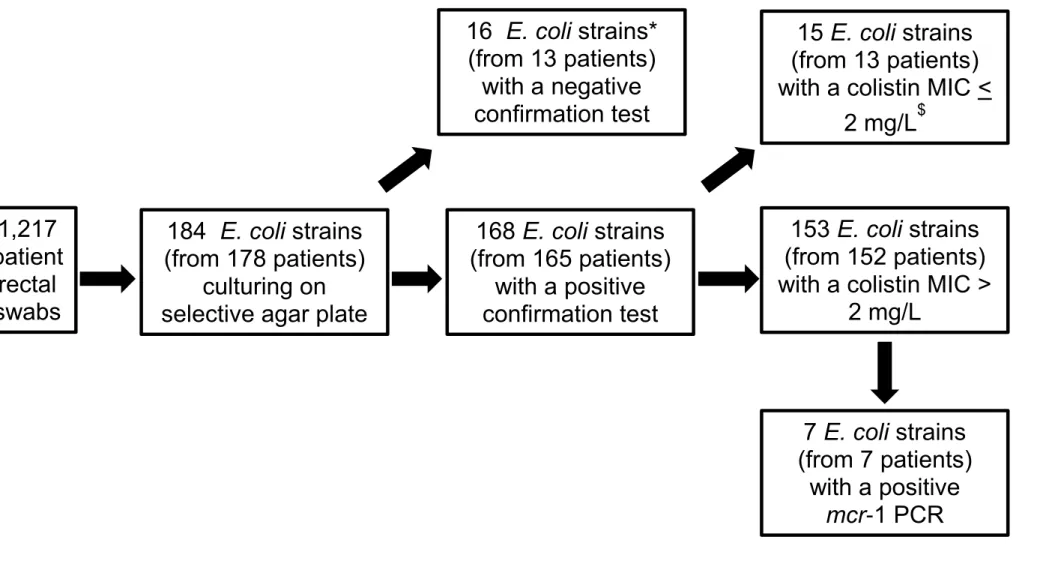Supplementary data
Methods
The list of antimicrobial compounds that were tested was through the disk diffusion assay included: amoxicillin, amoxicillin-clavulanic acid, ticarcillin, ticarcillin-clavulanic acid, piperacillin, piperacillin-tazobactam, temocillin, cefoxitin, cefixime, ceftazidime, cefotaxime, cefepim,aztreonam ertapenem, meropenem, imipenem, amikacin, gentamicin, tobramycin, netilmicin, cotrimoxazole, norfloxacin, ofloxacin, levofloxacin, ciprofloxacin, fosfomycin, tigecycline.
Whole-genome sequences obtained from Illumina NextSeq 2x150 bp were analysed with an in-house bioinformatic pipeline named PETANC for “Plasmid-Exploration Typing Assembly N’Contig-ordering”, which we describe below.
MLST (Warwick and Pasteur Institute schemes) and serotype are determined using SRST2 0.2.0 with standard parameters.9 Previously unknown Warwick STs are determined on EnteroBase website (https://enterobase.warwick.ac.uk/). Genomes are assembled with SPAdes 3.10.0 with “careful” option. The distances between a set of 313 reference E. coli complete circularised genomes (Table S1) and the chromosome sequences of the studied isolates are estimated using Mash 1.1.1.50 The 5 closest reference genomes for each studied isolate are determined with an in-house biopython script.51 These are used as reference for Ragout software, with option “solid-scaffolds”, to determine the order of the contigs and therefore enhance the assembly quality.7 Subsequently, the phylogroup of each isolate is determined with the ClermonTyper.8 Then, Abricate is used (https://github.com/tseemann/abricate) to determine i) the resistome with the Resfinder database using minimum identity (minID) of 95% and minimum coverage (minCOV) of 90%, ii) the virulome (minID 90%, minCOV 90%) with a custom database mixing Virulencefinder,
VFDB, and specific genes from extra-intestinal E. coli (Table S2), iii) the plasmid type with PlasmidFinder database (minID 90%, mincov 90%).10,11,52,53 InPEC and ExPEC virulence scores were computed based on presence/absence of InPEC and ExPEC virulence genes as previously described.34,54 Subsequently, chromosome and plasmid sequences are predicted with PlaScope and resistome and virulome are reassessed in the same way on the predictions to determine gene’s location.12,55
Table S1. Accession number of 313 E. coli reference genomes for Ragout ordering
NC_000913 NC_013364 NZ_AP014857 NZ_CP009166 NZ_CP010170 NZ_CP010344 NZ_CP012127 NZ_CP014316 NZ_CP015912 NZ_CP018237 NZ_CP019629 NC_002695 NC_013654 NZ_CP005930 NZ_CP009273 NZ_CP010171 NZ_CP010371 NZ_CP012625 NZ_CP014348 NZ_CP015995 NZ_CP018239 NZ_CP019777 NC_004431 NC_013941 NZ_CP005998 NZ_CP009644 NZ_CP010172 NZ_CP010438 NZ_CP012631 NZ_CP014488 NZ_CP016007 NZ_CP018241 NZ_CP019778 NC_007779 NC_016902 NZ_CP006027 NZ_CP009685 NZ_CP010176 NZ_CP010439 NZ_CP012633 NZ_CP014492 NZ_CP016018 NZ_CP018243 NZ_CP019903 NC_007946 NC_017625 NZ_CP006262 NZ_CP009789 NZ_CP010177 NZ_CP010440 NZ_CP012635 NZ_CP014495 NZ_CP016182 NZ_CP018245 NZ_CP019944 NC_008253 NC_017626 NZ_CP006632 NZ_CP009859 NZ_CP010178 NZ_CP010441 NZ_CP012693 NZ_CP014497 NZ_CP016358 NZ_CP018247 NZ_CP020048 NC_008563 NC_017628 NZ_CP006636 NZ_CP010116 NZ_CP010180 NZ_CP010442 NZ_CP012802 NZ_CP014522 NZ_CP016404 NZ_CP018250 NZ_CP020055 NC_009800 NC_017631 NZ_CP007025 NZ_CP010117 NZ_CP010183 NZ_CP010443 NZ_CP012868 NZ_CP014583 NZ_CP016497 NZ_CP018252 NZ_CP020058 NC_009801 NC_017632 NZ_CP007133 NZ_CP010119 NZ_CP010186 NZ_CP010444 NZ_CP012869 NZ_CP014641 NZ_CP016546 NZ_CP018770 NZ_CP020092 NC_010468 NC_017633 NZ_CP007136 NZ_CP010121 NZ_CP010191 NZ_CP010445 NZ_CP012870 NZ_CP014642 NZ_CP016625 NZ_CP018801 NZ_CP020106 NC_010473 NC_017634 NZ_CP007149 NZ_CP010122 NZ_CP010196 NZ_CP010585 NZ_CP013025 NZ_CP014667 NZ_CP016628 NZ_CP018948 NZ_CP020107 NC_010498 NC_017635 NZ_CP007265 NZ_CP010125 NZ_CP010200 NZ_CP010816 NZ_CP013029 NZ_CP014670 NZ_CP017100 NZ_CP018953 NZ_CP020116 NC_011353 NC_017638 NZ_CP007390 NZ_CP010129 NZ_CP010206 NZ_CP010876 NZ_CP013031 NZ_CP015020 NZ_CP017249 NZ_CP018957 NZ_CP020368 NC_011415 NC_017641 NZ_CP007391 NZ_CP010132 NZ_CP010213 NZ_CP011018 NZ_CP013112 NZ_CP015023 NZ_CP017251 NZ_CP018962 NZ_CP020543 NC_011601 NC_017646 NZ_CP007392 NZ_CP010133 NZ_CP010219 NZ_CP011061 NZ_CP013190 NZ_CP015069 NZ_CP017434 NZ_CP018965 NZ_HF572917 NC_011740 NC_017651 NZ_CP007393 NZ_CP010134 NZ_CP010221 NZ_CP011113 NZ_CP013253 NZ_CP015074 NZ_CP017436 NZ_CP018970 NZ_HG738867 NC_011741 NC_017652 NZ_CP007394 NZ_CP010137 NZ_CP010226 NZ_CP011124 NZ_CP013483 NZ_CP015076 NZ_CP017438 NZ_CP018976 NZ_HG941718 NC_011742 NC_017656 NZ_CP007442 NZ_CP010140 NZ_CP010228 NZ_CP011134 NZ_CP013658 NZ_CP015138 NZ_CP017440 NZ_CP018979 NZ_LM993812 NC_011748 NC_017660 NZ_CP007491 NZ_CP010143 NZ_CP010229 NZ_CP011320 NZ_CP013662 NZ_CP015159 NZ_CP017442 NZ_CP018983 NZ_LM995446 NC_011750 NC_017663 NZ_CP007592 NZ_CP010145 NZ_CP010230 NZ_CP011321 NZ_CP013663 NZ_CP015228 NZ_CP017444 NZ_CP018991 NZ_LN832404 NC_011993 NC_017664 NZ_CP007594 NZ_CP010148 NZ_CP010231 NZ_CP011324 NZ_CP013831 NZ_CP015229 NZ_CP017446 NZ_CP018995 NZ_LT601384 NC_012759 NC_017906 NZ_CP007799 NZ_CP010150 NZ_CP010235 NZ_CP011331 NZ_CP013835 NZ_CP015240 NZ_CP017631 NZ_CP019000 NZ_LT615377 NC_012892 NC_018650 NZ_CP008697 NZ_CP010151 NZ_CP010236 NZ_CP011342 NZ_CP014197 NZ_CP015241 NZ_CP017669 NZ_CP019005 NZ_LT615378 NC_012947 NC_018658 NZ_CP008801 NZ_CP010152 NZ_CP010237 NZ_CP011343 NZ_CP014225 NZ_CP015831 NZ_CP017844 NZ_CP019008 NC_012967 NC_018661 NZ_CP008805 NZ_CP010157 NZ_CP010238 NZ_CP011416 NZ_CP014268 NZ_CP015832 NZ_CP018103 NZ_CP019012 NC_012971 NC_020163 NZ_CP008957 NZ_CP010160 NZ_CP010240 NZ_CP011495 NZ_CP014269 NZ_CP015834 NZ_CP018109 NZ_CP019015 NC_013008 NC_020518 NZ_CP009072 NZ_CP010163 NZ_CP010242 NZ_CP011938 NZ_CP014270 NZ_CP015842 NZ_CP018115 NZ_CP019020 NC_013353 NC_022364 NZ_CP009104 NZ_CP010167 NZ_CP010304 NZ_CP012125 NZ_CP014272 NZ_CP015843 NZ_CP018121 NZ_CP019029 NC_013361 NC_022648 NZ_CP009106 NZ_CP010169 NZ_CP010315 NZ_CP012126 NZ_CP014314 NZ_CP015846 NZ_CP018206 NZ_CP019213
Table S2. Specific extra-intestinal E. coli virulence genes with their name and accession
number
Gene name Accession number
cea U15633 Chromosomal_ompT CP025268:583729-584682 clbQ AE014075:2265084-2265806 cvaC CP019268:43764-44075 Episomal_ompT CP019282:79325-80278 etsC JX077110:124931-126301 fyuA CP009836:3377794-3379815 hek CP000243:4785401-4786156 hlyF CU928146:131210-132331 irp2 CP006806:2552888-2558995 kpsE CU928164:3584271-3585419 malX CP000247:1618614-1620206 mcbA M24253:408-614 neuC M84026 papGI X61239:8679-9686 papGII AE014075:3429593-3430603 papGIII CP000243:4789101-4790108 terC AE005174:1102902-1103942 tia CU928161:3229672-3230427 traT J01769.1:403-1134 usp CP000247:123276-125057 hra U07174.1:83-826
Table S3. The antimicrobial susceptibility, the resistome and the genetic support of the mcr-1 gene of the plasmid mediated colistin resistant E. coli strains Strain ID Colistin MIC (mg/L) Antimicrobial resistance*
Resistome** mcr genetic support
Acquired gene Chromosomal
mutation Incompatibility group Associated resistance 370D 4 AMP, LLFQ, SXT
strB, strA, aadA2, aph(3’)-Ia, oqxA, oqxB, dfrA12, tet(B), tet(M),
sul2, sul3, cmlA1 gyrA (S83L) IncX4 none
436A 4 SXT strB, strA, aadA5, qnrS1, dfrA17, tet(A), sul2 - IncX4 none
635A 4 AMP, GTN,
SXT
blaTEM-1b, strB, strA, aadA2, aph(3’)-Ic, aac(3)-IId, qnrS1,
dfrA12, tet(A), tet(M), sul1, sul3, catA2, mph(A) - IncX4 none
925B 8 HLFQ - gyrA (S83L, D87N), parC (S80I) IncI2 none 933A 8 AMP, HLFQ,
SXT blaTEM-1b, strB, strA, dfrA14, tet(A), sul2, floR, catA1
gyrA (D87G, S83L) parC (E84G, S80I) IncHI2 none 1057A 4 AMP, GTN, HLFQ
blaTEM-1b, aadA2, aph(4)-Ia, aph(3’)-Ia, aac(3)-Iva, tet(A), tet(M), sul2, sul3, cmlA1, floR,mph(A)
gyrA (S83L,
D87N), parC (S80I)
IncHI2 ND***
1263A 4 AMP, LLFQ,
SXT blaTEM-1b, strB, strA, dfrA1, tet(A) sul1, sul2 gyrA (S83L) IncI2 none
* Acquired resistance to ampicillin (AMP), fluoroquinolones (low level: LLFQ, high level: HLFQ), cotrimoxazole (SXT), gentamicin / tobramycin / netilmicin (GTN) determined by disk diffusion method.
** The detection of the resistances is based on the whole genome sequence data. *** ND=not done.
Figure S1. Map of the University hospitals of Paris (“Assistance Publique-Hôpitaux de Paris”) with Paris intra-muros in blue and
its suburb outside in white. The six hospitals where the Coli-RED study was performed are indicated. For each hospital, the name of the hospital is provided. For the four suburb hospitals, the code of the district followed by the town are indicated. The number close to each hospital corresponds to the number of beds.
451 543 806 976 700 300
Figure S2. Flow chart of the ColiRED study showing the strategy used for the screening of colistin resistant E. coli strains in 1,217 patients.
1,217
patient
rectal
swabs
184 E. coli strains
(from 178 patients)
culturing on
selective agar plate
168 E. coli strains
(from 165 patients)
with a positive
confirmation test
153 E. coli strains
(from 152 patients)
with a colistin MIC >
2 mg/L
16 E. coli strains*
(from 13 patients)
with a negative
confirmation test
15 E. coli strains
(from 13 patients)
with a colistin MIC <
2 mg/L
$7 E. coli strains
(from 7 patients)
with a positive
mcr-1 PCR
* all the 16 strains exhibited a colistin MIC < 2 mg/L and a negative mcr PCR
$
Figure S3. Genetic environment of the plasmid-borne mcr-1 genes.
Strains are indicated by their ID and ordered as in Table S3. Coding sequences in a window of 5 kbp around mcr-1 gene are represented by arrows. Contig borders are indicated by black vertical lines. The mcr related CDS are in red, pap2 genes in blue (hatched if fragmented), and ISApl1 related sequences in green.
Table S5. Mutations in pmrA and pmrB genes altering the length of the predicted proteins
Strain ID ST Warwick ST Pasteur Phylogroup Serotype Protein Nucleic variation Proteic variation Type of mutation MIC
130A 131 43 B2 O25b:H4 PmrA 505_510del V169del/H170del 2 A.A. deletion 8
353A 69 77 D O17:H18 PmrB 329T<G L110X Truncating mutation 8
389A 165 898 A Unknown:H10 PmrB 329T<G L110X Truncating mutation 4
12B 961 882 B2 O4:H5 PmrB 151_412dup S138KfsX10 Truncating mutation 8
411A 38 8 D O86:H18 PmrB
143_144delTAinsGGG /
149delAinsCTAT L48RfsX14 Truncating mutation 8
156A 10 2 A O8:H4 PmrB 209_238dup I70_L79dup 10 A.A. duplication 8
619A 38 535 D O7:H18 PmrB 209_238dup I70_L79dup 10 A.A. duplication 4
962A 1604 884 B2 O75:H5 PmrB 587_592dup L199_A200dup 2 A.A. duplication 8
142A 62 757 F O7:H45 PmrB 200_229del A67_M76_del 10 A.A. deletion 8
383A 5924 880 B2 O18:H4 PmrB 289_303del E97_E101del 5 A.A. deletion 16
393A 421 70 B2 O1:H7 PmrB 291_303del L98_E101del 4 A.A. deletion 8
775A 12 35 B2 O4:H5 PmrB 343_351del I115_S117del 3 A.A. deletion 16




